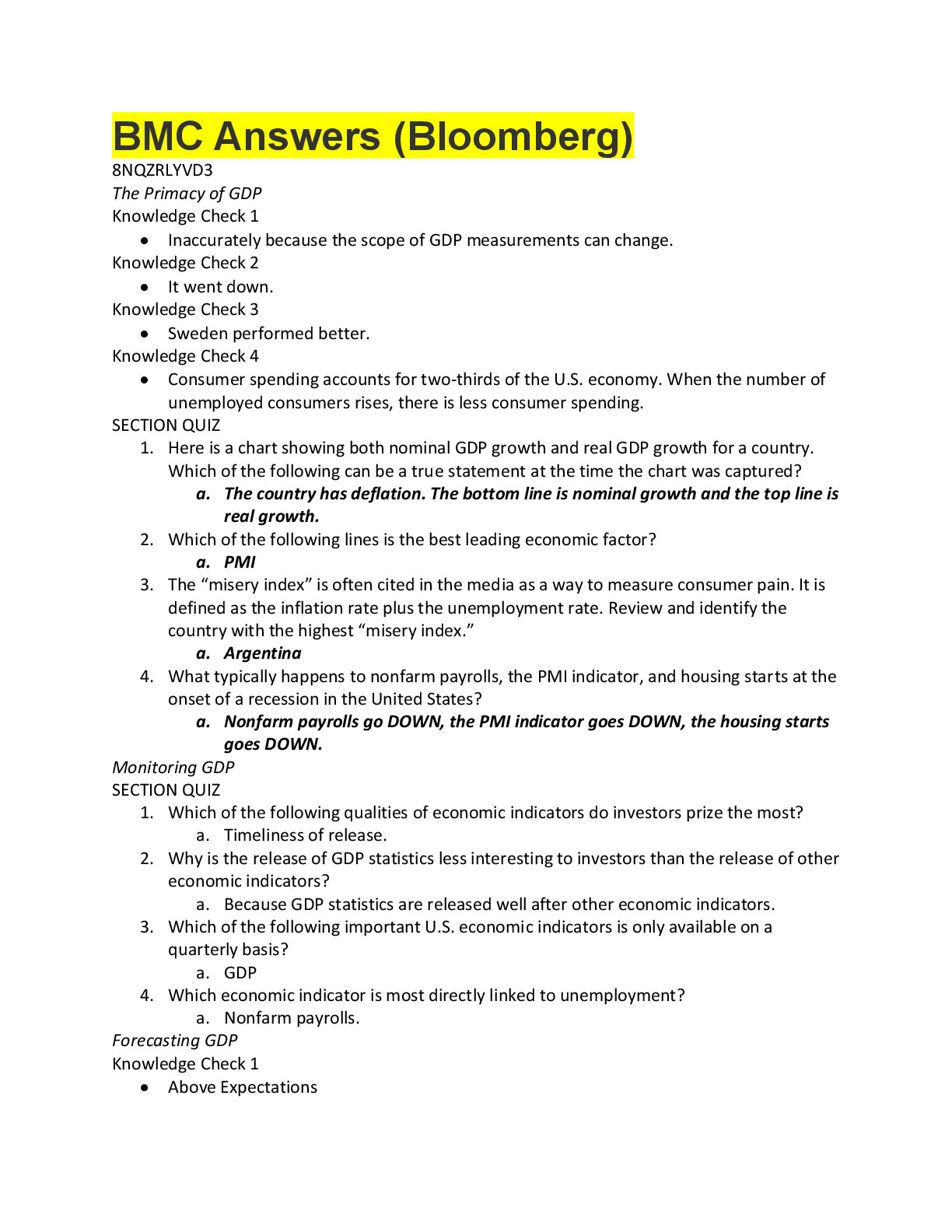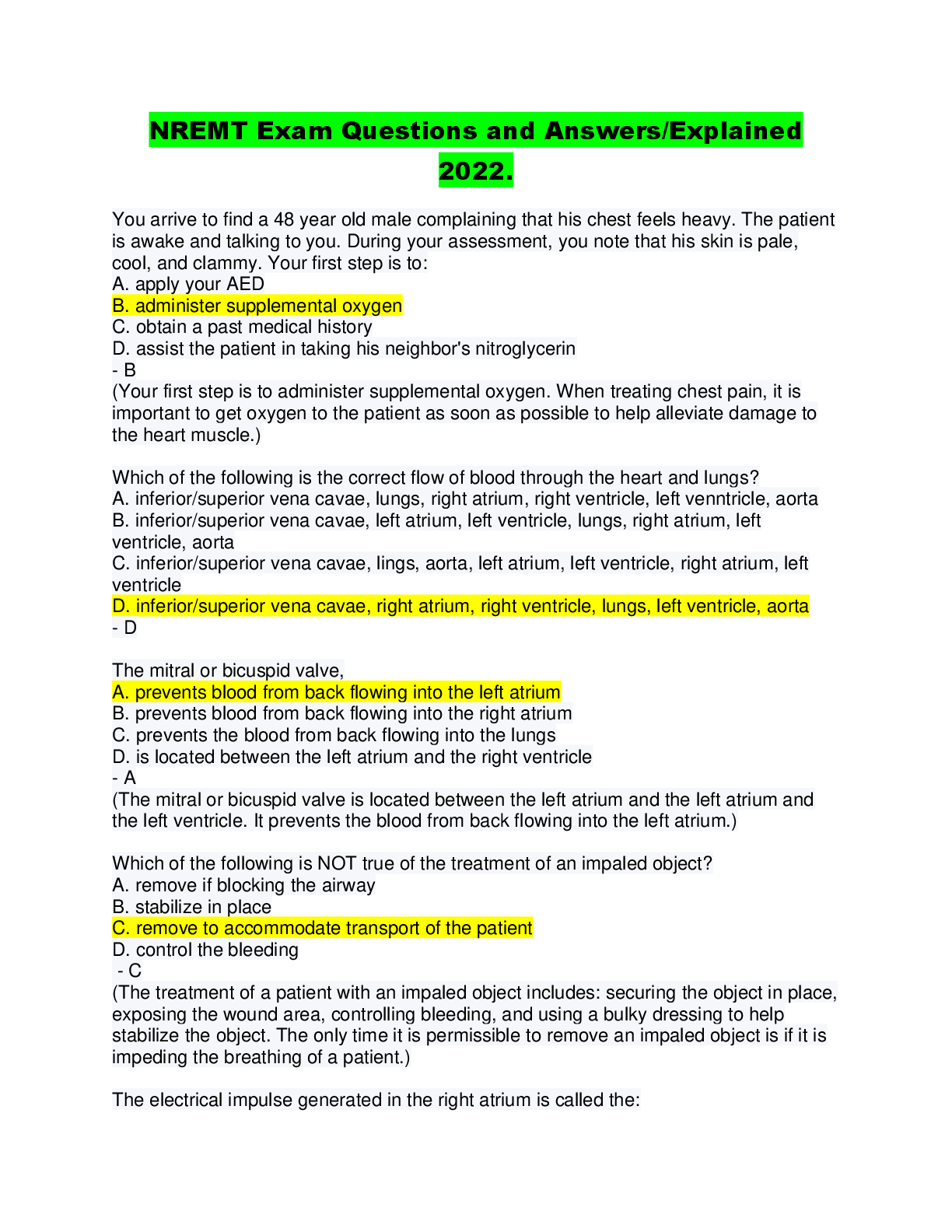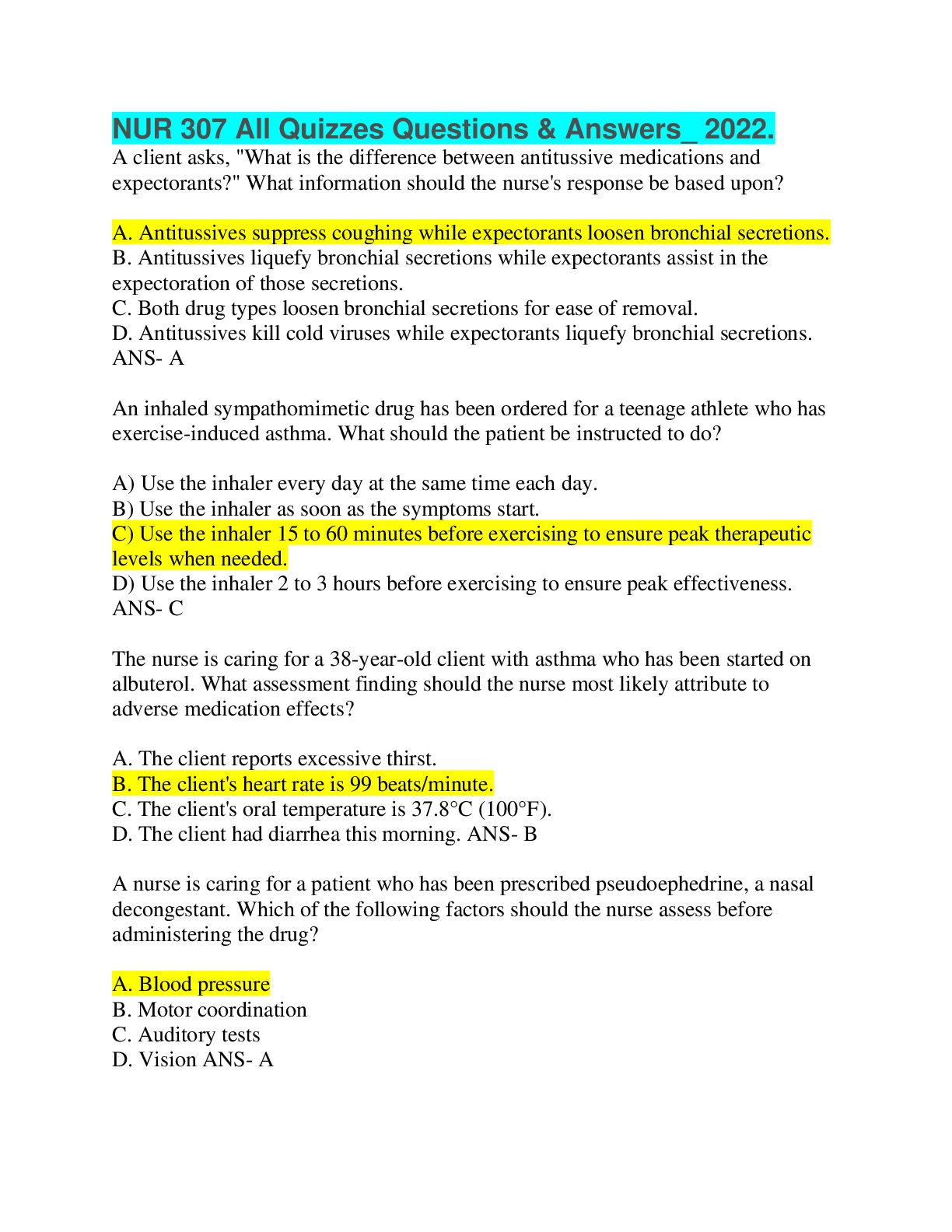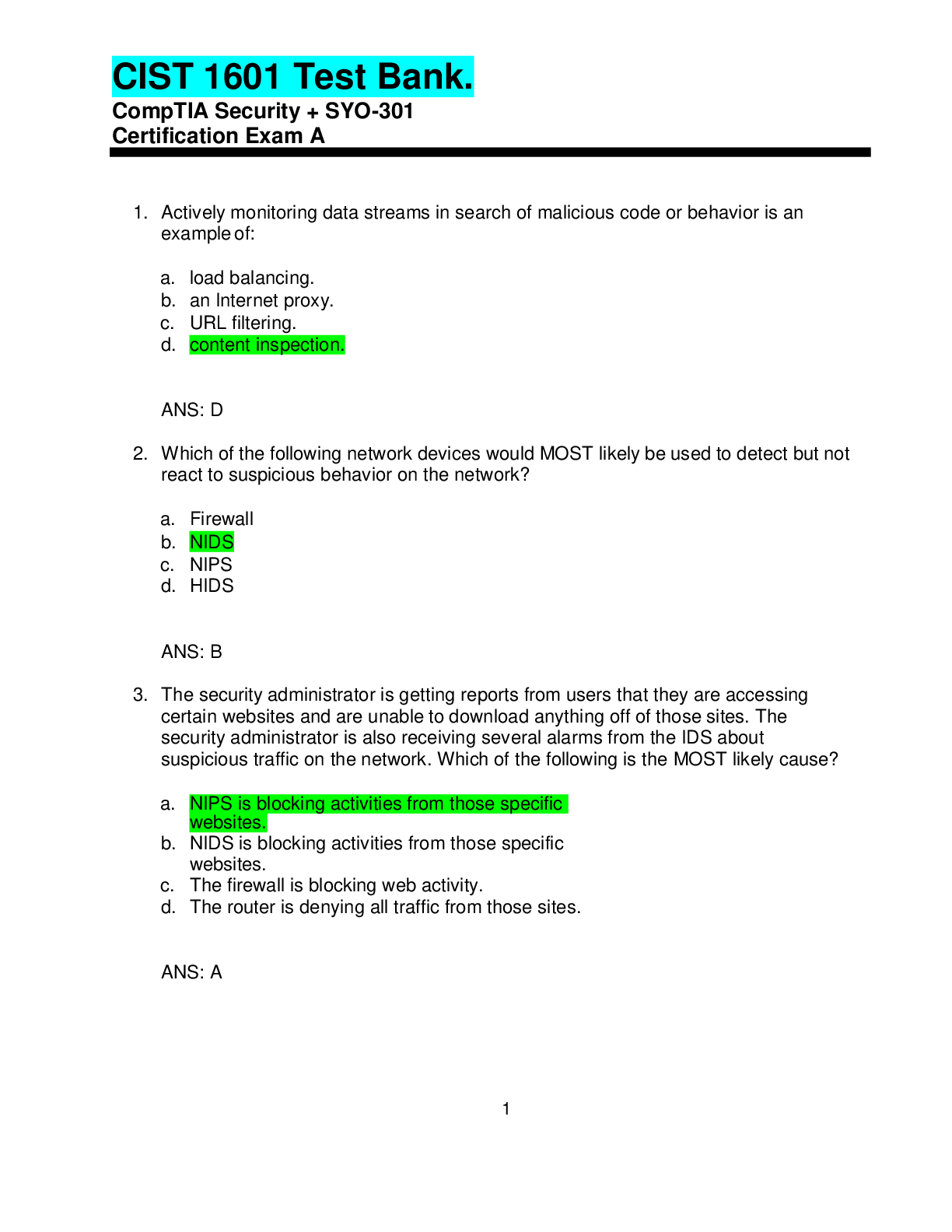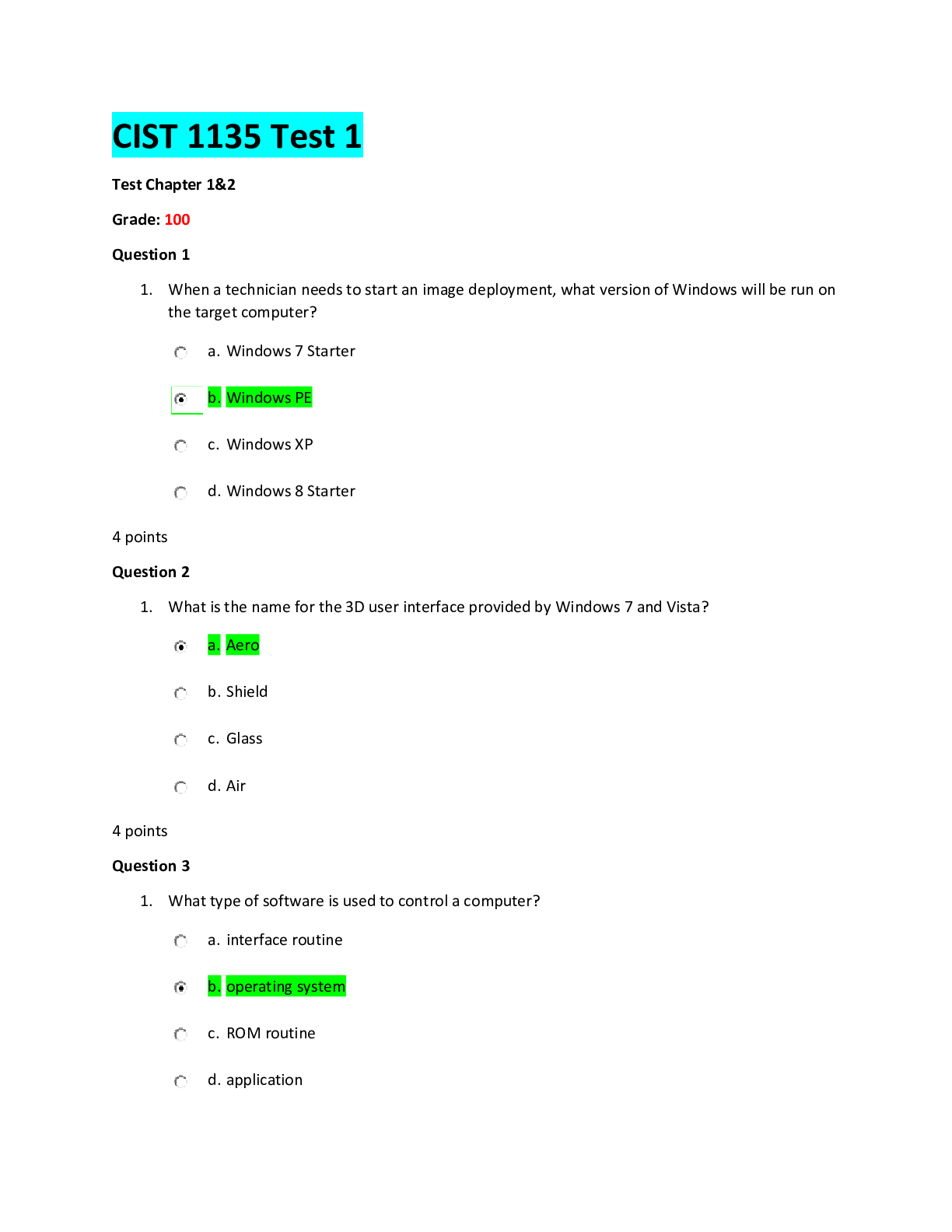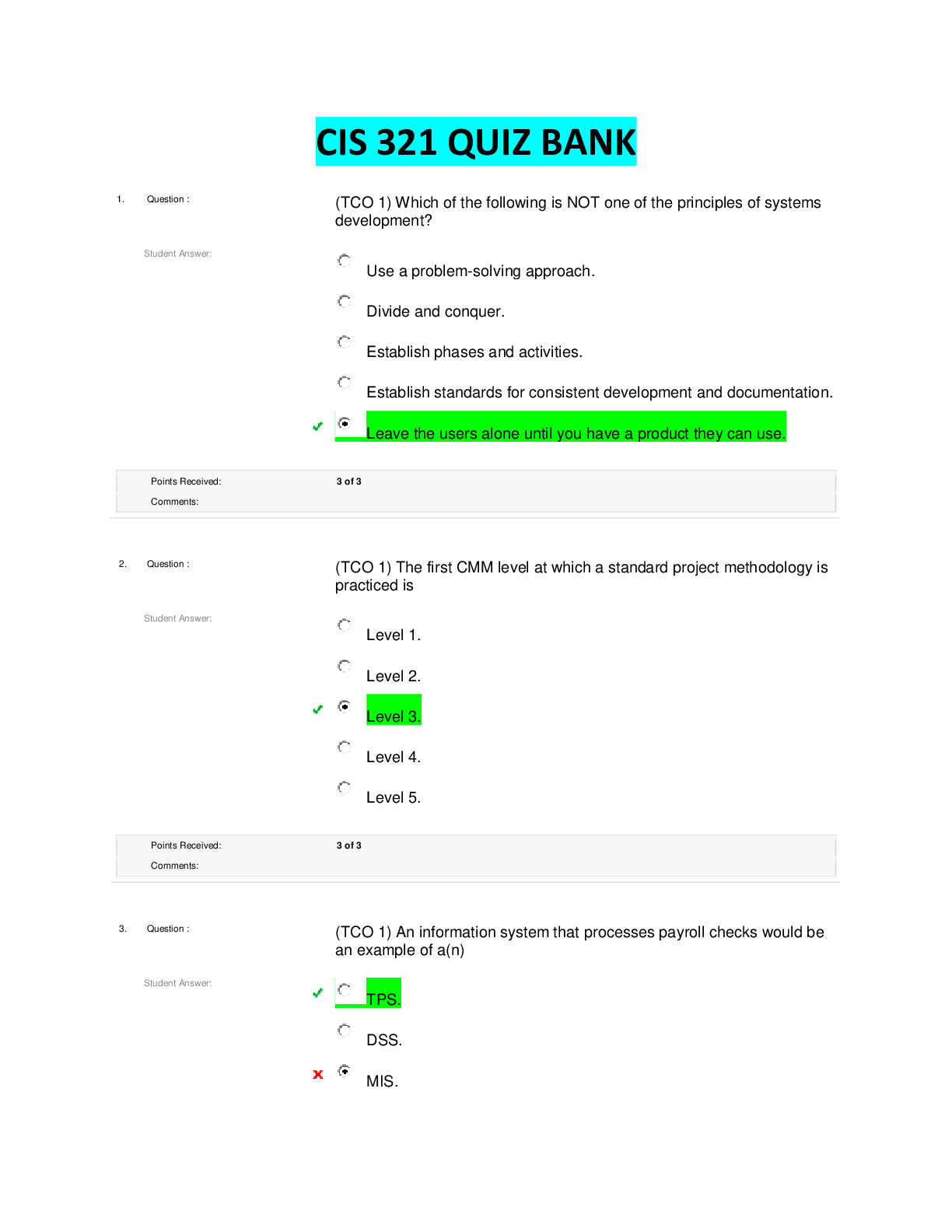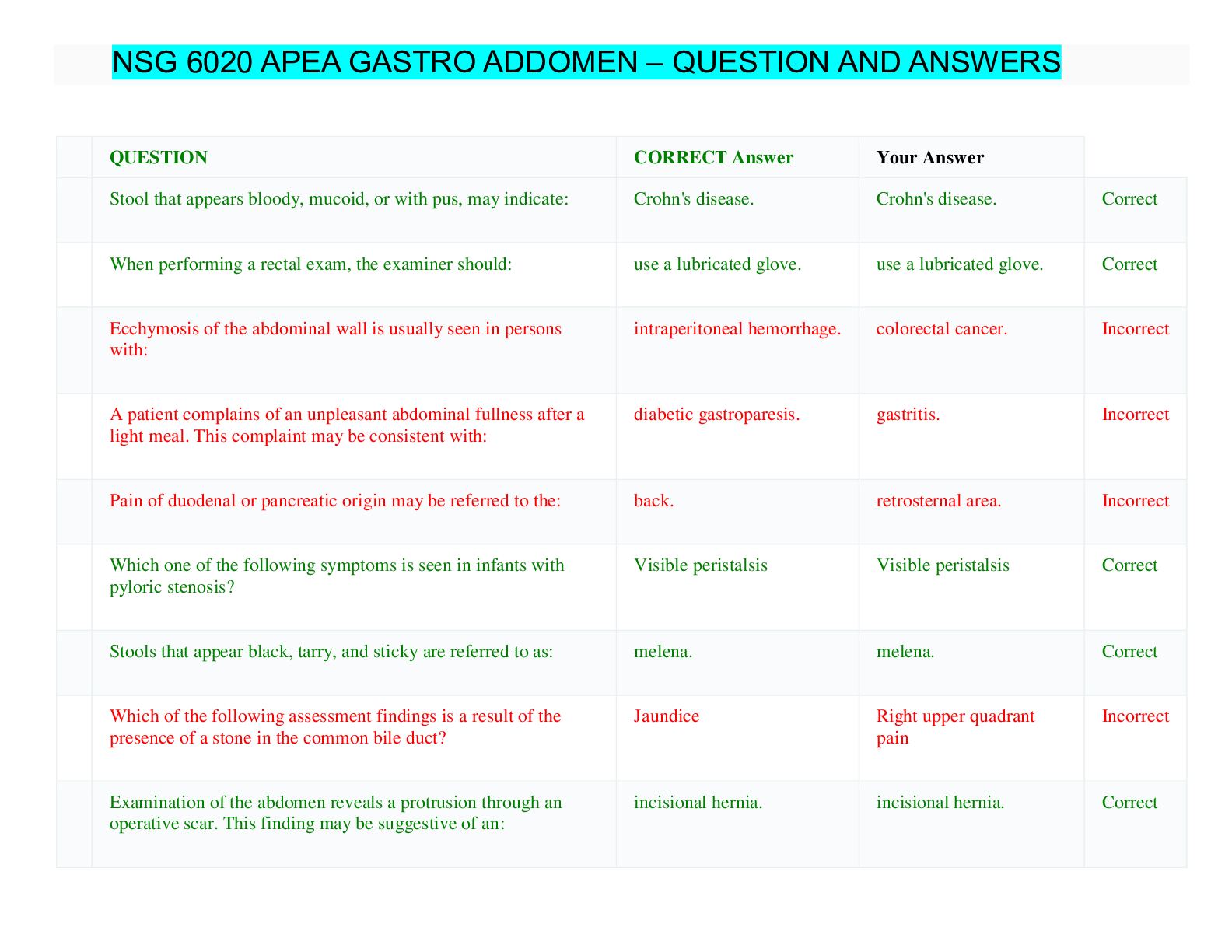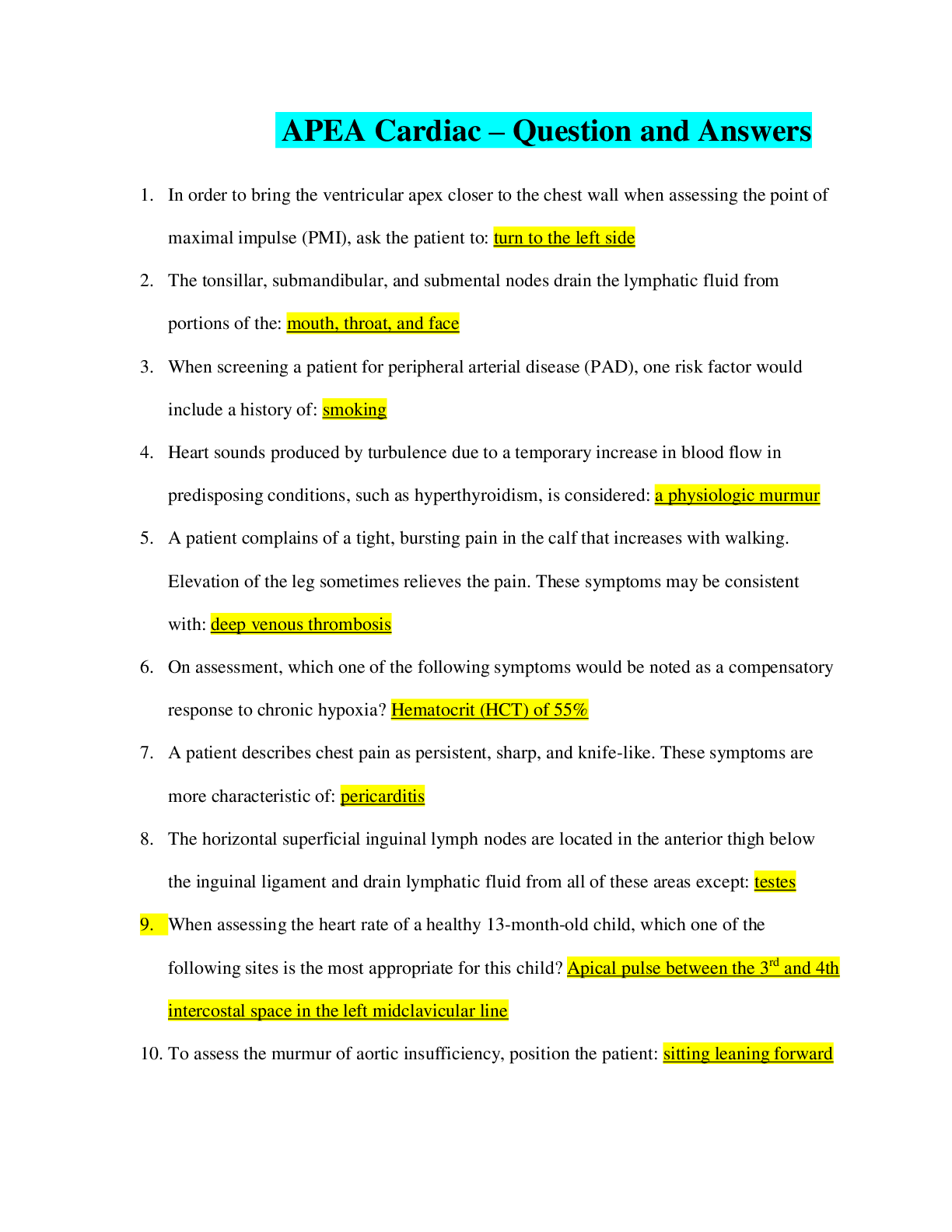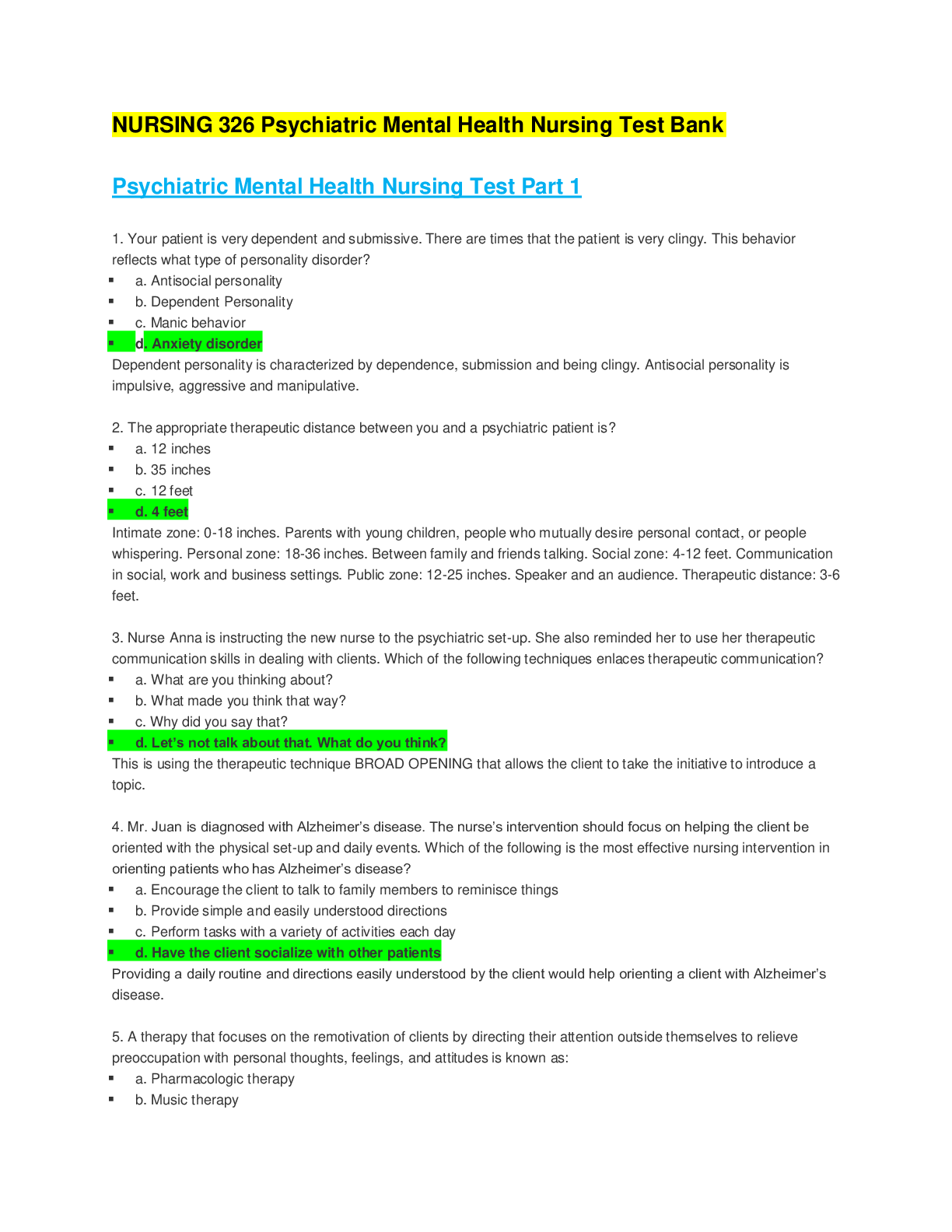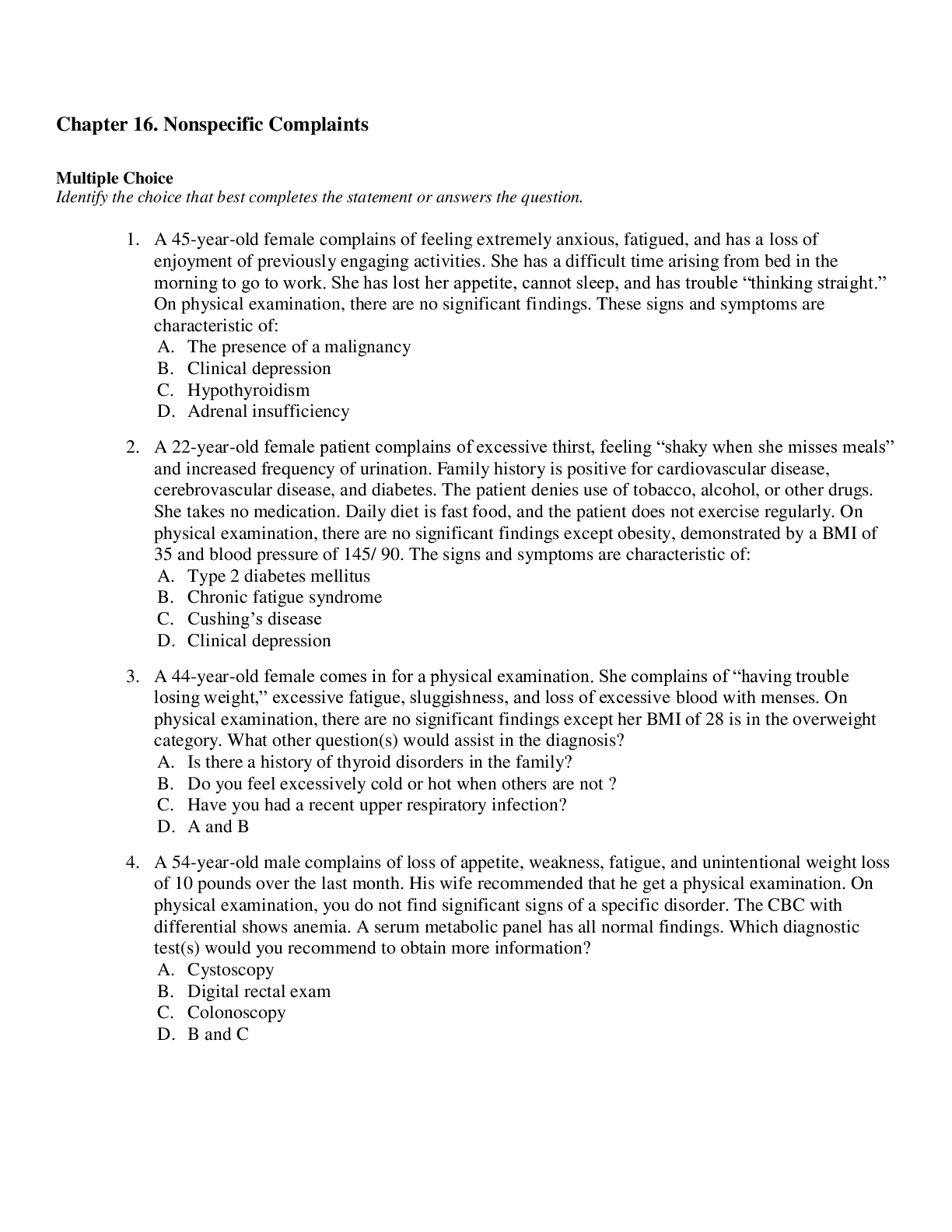Biology > QUESTIONS & ANSWERS > BIO 195 Weekly Quiz Bank Answers (Weeks 1 – 7) complete solution. (All)
BIO 195 Weekly Quiz Bank Answers (Weeks 1 – 7) complete solution.
Document Content and Description Below
BIO 195 Weekly Quiz Answers (Weeks 1 – 7) 1. Question (TCO 1) The process by which unspecialized cells become specialized cells is called 2. Question (TCO 1) The release of insulin from pancreati... c islet cells in response to an increase in the blood glucose concentration after a meal is an example of which of the following life processes? 3. Question (TCO 1) The plane that divides the body into unequal left and right portions is called a (n) 4. Question (TCO 1) Which of the following is NOT one of the nine abdominopelvic regions? 5. Question (TCO 2) The most common type of chemical bond in the human body is 6. Question (TCO 2) In the human body, glycogen is commonly stored in the cells of the 7. Question (TCO 2) DNA and RNA are large polymers composed of repeating building blocks called 8. Question (TCO 2) Which of the following is a common second messenger used in signaling pathways activated by water-soluble hormones? 9. Question (TCO 2) Antidiuretic hormone and oxytocin are secreted from the 10. Question (TCO 2) Which of the following types of cells found in the thyroid gland produce thyroxine? 11. Question (TCO 3) The movement of solute molecules across a plasma membrane from an area of low solute concentration to an area of high solute concentration requires 12. Question (TCO 3) Which of the following statements is NOT TRUE with regard to the cytoplasm? 13. Question (TCO 3) When translation of a particular protein is complete, termination of protein synthesis is indicated by the presence of a (n) 14. Question (TCO 3) The type of cell division that produces two identical cells is called 15. Question (TCO 3) A type of epithelial tissue containing cells that can change shapes as the tissue stretches is called 16. Question (TCO 3) All of the following are classified as loose connective tissue EXCEPT 17. Question (TCO 3) Which of the following types of tissue contains neuroglia cells? 18. Question (TCO 3) Cells of the skin’s epidermis that participate in the immune response to microbes are called 19. Question (TCO 3) Exocrine glands that secrete oil directly on to hair follicles are called 20. Question (TCO 3) Which layer of skin contains large numbers of blood capillaries involved in body temperature regulation? 21. Question (TCO 4) The layer of the GI tract wall containing networks of enteric neurons that control the secretory activity of the GI tract is called the 22. Question (TCO 4) Amylase is an enzyme secreted into the oral cavity to start the digestion of 23. Question (TCO 4) Storage of glycogen, vitamins (A, D, E, K), and minerals (iron and copper), along with detoxification of chemicals like ammonia, are functions of the 24. Question (TCO 4) Most of the nutrients have been absorbed from the chyme by the time it reaches the 25. Question (TCO 4) The portion of peritoneum that anchors the small intestines to the posterior abdominal wall is called the 26. Question (TCO 4) Which of the following statements does NOT describe minerals? 27. Question (TCO 4) Which of the following hormones stimulates glycogen synthesis in liver and muscle cells? 28. Question (TCO 4) When glucose is catabolized under aerobic conditions, the largest number of ATP molecules are directly produced by the 29. Question (TCO 4) The thermostat of the human body is located in the 30. Question (TCO 4) Which of the following hormones is the MAIN regulator of the basal metabolic rate? 31. Question (TCO 6) The nervous system and the _____ system share the greatest responsibility for maintaining homeostasis. 32. Question (TCO 6) The neuroglial cell that lines the ventricles of the brain and the central canal of the spinal cord is called a (n) 33. Question (TCO 6) Which of the following statements best describes the events that lead to depolarization of a neuronal membrane? 34. Question (TCO 6) The subarachnoid space is located between the 35. Question (TCO 6) In someone who suffered a stroke that interfered with their ability to speak, the damage could involve any of the following areas in the brain EXCEPT the 36. Question (TCO 6) Which of the following best describes a characteristic of the pineal gland? 37. Question (TCO 6) Temporary cerebral dysfunction caused by a decrease in blood flow to one portion of the brain that usually leaves no permanent damage is called 38. Question (TCO 7) The sensation of itch results from the stimulation of 39. Question (TCO 7) Which of the following structures is part of the vascular tunic of the eye? 40. Question (TCO 7) The sensors for maintaining dynamic equilibrium are located in the 41. Question (TCO 8) An increase in the number of white blood cells is called 42. Question (TCO 8) The threads that hold a blood clot together are formed by 43. Question (TCO 8) Which of the following vessels carries blood with the highest concentration of oxygen under normal conditions? 44. Question (TCO 8) Atherosclerosis is a condition in which 45. Question (TCO 8) The endothelium that lines all blood vessels consists of 46. Question (TCO 8) Under normal conditions, blood pressure is highest in the 47. Question (TCO 8) Which of the following arteries branch directly from the brachial artery? 48. Question (TCO 9) The exchange of gases that occurs during external respiration takes place in the 49. Question (TCO 9) Deep labored inhalations involve contraction of all of the following muscles EXCEPT the 50. Question (TCO 9) Under resting conditions, the basic rhythm of breathing is controlled by the 51. Question (TCO 10) The peritubular capillaries drain directly into the 52. Question (TCO 10) The glomerular filtration rate in a normal adult male is about 53. Question (TCO 10) All of the following are solutes normally found in urine EXCEPT 54. Question (TCO 10) The tubular structure that connects a kidney to the urinary bladder is the 55. Question (TCO 10) Inflammation of the glomeruli of the kidney is referred to as 56. Question (TCO 10) All of the following are true about testosterone EXCEPT 57. Question (TCO 10) All of the following hormones are involved in promoting and regulating various aspects of lactation EXCEPT 58. Question (TCO 10) Menstruation is directly caused by a decrease in the ovarian secretion of 59. Question (TCO 10) All common forms of oral contraceptives contain a drug that mimics the regulatory effects of 60. Question (TCO 10) Absence of menstruation is called [Show More]
Last updated: 7 months ago
Preview 1 out of 5 pages

Buy this document to get the full access instantly
Instant Download Access after purchase
Buy NowInstant download
We Accept:

Reviews( 0 )
$14.00
Can't find what you want? Try our AI powered Search
Document information
Connected school, study & course
About the document
Uploaded On
Feb 25, 2020
Number of pages
5
Written in
Additional information
This document has been written for:
Uploaded
Feb 25, 2020
Downloads
0
Views
124

